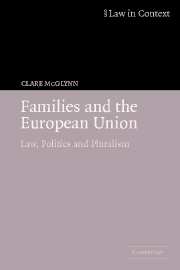Book contents
- Frontmatter
- Contents
- Preface
- Acknowledgments
- Table of cases
- Table of legislation and documents
- 1 Pluralism and human rights: a legal foundation for the regulation of families and family law in the European Union
- 2 Families, ideologies and value pluralism: towards an expanded concept of family
- 3 Children and European Union law: instrumentalism, protection and empowerment
- 4 Parenthood and European Union law: old ideologies and new ideals
- 5 European Union law and the regulation of intimate relationships: marriage, partnerships and human rights
- 6 The emergence of a European Union family law
- 7 Harmonisation, codification and the future of family law in the European Union
- Bibliography
- Index
2 - Families, ideologies and value pluralism: towards an expanded concept of family
Published online by Cambridge University Press: 04 July 2009
- Frontmatter
- Contents
- Preface
- Acknowledgments
- Table of cases
- Table of legislation and documents
- 1 Pluralism and human rights: a legal foundation for the regulation of families and family law in the European Union
- 2 Families, ideologies and value pluralism: towards an expanded concept of family
- 3 Children and European Union law: instrumentalism, protection and empowerment
- 4 Parenthood and European Union law: old ideologies and new ideals
- 5 European Union law and the regulation of intimate relationships: marriage, partnerships and human rights
- 6 The emergence of a European Union family law
- 7 Harmonisation, codification and the future of family law in the European Union
- Bibliography
- Index
Summary
The ‘dominant ideology of the family’ is that of a white, heterosexual, married couple, with children, all living under the same roof, where the husband is the main breadwinner and the wife the primary carer of children and other dependants. In other terminology, this is, of course, the traditional nuclear family. This is ‘the family’ which frames debates on families and family law and it is the ideal against which other family forms and practices are measured. It is also ‘the family’ which bears little comparison to the realities of family life in Europe today, yet it continues to exert significant force over judicial reasoning and legislative activity. This chapter examines, first, the dominant ideology of the family, before going on to outline the realities of family life, the new sociological explanations for changes in family practices and the new and emerging ideals of family life. It is argued that the European Union must embrace a more diverse, pluralist concept of family which should then form the basis for its regulation of families and emerging family law.
The dominant ideology of the family
The dominant ideology of the family reproduces stereotypes and norms for women, men and families, which may not reflect reality, but which frame discussion of issues and against which the legitimacy of individual claims are judged. As Diana Gittins suggests, the ideology of ‘the family’ has ‘influenced, and continues to influence, social policy and the ways in which laws are formulated and implemented for the population overall’.
- Type
- Chapter
- Information
- Families and the European UnionLaw, Politics and Pluralism, pp. 23 - 41Publisher: Cambridge University PressPrint publication year: 2006

